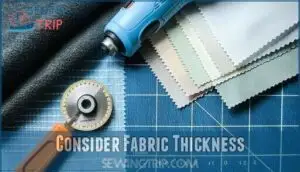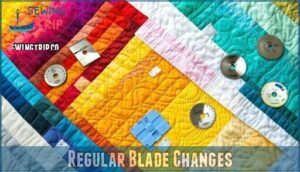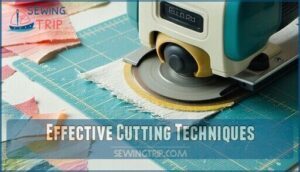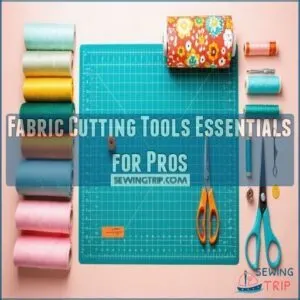This site is supported by our readers. We may earn a commission, at no cost to you, if you purchase through links.
 Rotary fabric cutting tools transform your quilting game with precision that’ll make scissors jealous.
Rotary fabric cutting tools transform your quilting game with precision that’ll make scissors jealous.
You’ll slice through eight fabric layers like butter using these circular-blade powerhouses, guided by rulers for laser-straight cuts.
Think pizza cutter meets surgical precision.
The ergonomic handles reduce hand fatigue during marathon quilting sessions, while titanium-coated blades stay sharper longer than traditional cutting tools.
Whether you’re strip-piecing or cutting delicate bias strips, these cutters maintain consistent pressure and angle for professional results every time.
Safety features like blade guards protect fingers from those razor-sharp edges.
The secret to choosing your perfect cutter involves matching blade size to fabric thickness and project requirements.
Table Of Contents
- Key Takeaways
- Rotary Cutter Basics
- Choosing Right Cutter
- Top 9 Rotary Cutters
- 1. Fiskars 45mm Contour Rotary Cutter
- 2. Fiskars 45mm Titanium Rotary Cutter with Comfort Grip
- 3. OLFA 60mm Ergonomic Rotary Cutter
- 4. Olfa 28mm Standard Rotary Fabric Cutter
- 5. Fiskars 45mm Rotary Fabric Cutter Titanium Blade
- 6. Martelli Ergo 2000 60mm Rotary Cutter Right Handed
- 7. Nicapa 45mm Rotary Cutter with 5 Extra Blades
- 8. Olfa RTY 2G Rotary Fabric Cutter
- 9. Electric Rotary Fabric Cutter 100mm Purple
- Cutter Maintenance Tips
- Effective Cutting Techniques
- Rotary Cutter Applications
- Frequently Asked Questions (FAQs)
- Conclusion
Key Takeaways
- You’ll get precision cuts through multiple fabric layers with rotary cutters that outperform scissors, especially when paired with rulers for laser-straight lines and consistent pressure control.
- You should match your blade size to your project needs – 28mm for detailed curves and delicate work, 45mm for general quilting versatility, and 60mm for cutting through thick fabrics or multiple layers.
- You’ll reduce hand fatigue during long cutting sessions by choosing ergonomic handles with comfort grips, and titanium-coated blades that stay sharp three times longer than standard steel blades.
- You must maintain your rotary cutter by replacing dull blades regularly, cleaning off fabric lint and residue buildup, and storing old blades safely in marked containers to ensure consistent cutting performance.
Rotary Cutter Basics
You’ll find that rotary cutters use a sharp circular blade that rolls across fabric to create clean, precise cuts that scissors simply can’t match.
These tools feature ergonomic handles for comfort, titanium-coated blades for durability, and essential safety features like blade guards to protect your fingers during cutting sessions.
Your rotary cutter becomes an extension of your hand—sharp, precise, and ready to transform every fabric project into professional perfection.
Ergonomic Handles
Your hand-fatigue nightmare ends with ergonomic handles on your rotary cutter.
These comfort-focused designs transform marathon cutting sessions into manageable tasks. Handle materials like cushioned rubber provide superior grip comfort, while ambidextrous design accommodates both righties and lefties. Different handle sizes guarantee you’ll find your perfect fit.
Consider also the benefits of a specialized rotary cutter for enhanced comfort.
- Fatigue reduction keeps you cutting longer without pain
- Comfort grip prevents slipping during precision work
- Ergonomic design supports natural hand positioning
- Handle comfort makes detailed quilting projects enjoyable
Titanium-Coated Blades
Your rotary cutter’s titanium-coated blades deliver unmatched cutting efficiency and blade sharpness that outlasts steel three times longer.
Sharp titanium blades slice through fabric like butter—three times the durability of ordinary steel.
These premium rotary blades feature superior titanium durability and corrosion resistance, making them worth the investment despite higher upfront costs.
A cost analysis reveals two titanium blades equal five steel ones in longevity.
For serious fabric cutting projects, titanium-coated blades slice through multiple layers effortlessly while maintaining precision cuts.
You’ll experience less hand strain and cleaner edges with every quilting session using these advanced blade durability innovations.
Safety Features
Beyond sharp blades lies another priority: your safety.
Blade guards protect fingers when you’re not cutting, while retractable blades automatically hide after use.
Handle locks prevent accidental activation, and safety locks secure the blade during storage.
Look for ambidextrous design if you’re left-handed.
These safety features shield against cutting hazards and guarantee child safety.
Smart rotary cutter design puts protection first, letting you focus on perfect cuts instead of potential accidents.
Choosing Right Cutter
You’ll need to match your rotary cutter to your specific fabric types and projects for the best cutting results.
Consider blade size, handle comfort, and safety features when selecting your cutter to guarantee clean, precise cuts every time.
Consider Fabric Thickness
Think of fabric thickness as your project’s foundation.
You’ll need the right blade size for success: 28mm rotary blades slice delicate materials and tight curves, while 60mm options power through heavy fabric layers.
Your rotary cutter should match the blade material to your project’s demands.
Use proper cutting mats to support thick fabrics, and consider models with adjustable settings.
When fabric cutting becomes difficult, it’s time to upgrade your rotary blade for peak performance.
Consider Project Type
What’s your next creation? Your project type determines which rotary cutter you’ll need.
Garment Sewing demands precision—28mm blades excel at curves and detailed work.
Quilting Needs call for 45mm cutters that slice through multiple fabric layers effortlessly.
Home Decor projects with thick materials benefit from 60mm blades.
Craft Projects and Mixed Media work require versatile mid-range options.
Match your rotary cutter to fabric thickness and complexity—this guarantees clean cuts every time.
Safety Features to Look For
Safety should never take a backseat when selecting your rotary cutter. Modern cutters include essential safety features that protect you during cutting sessions.
- Blade guards and retractable blades shield you from accidental contact
- Handle locks and safety latches prevent unexpected blade exposure
- Ambidextrous design guarantees comfortable, controlled cutting for all users
- Blade storage compartments keep spare blades secure and organized
These accident prevention features transform your rotary cutter into a reliable, worry-free tool for all quilting projects.
Top 9 Rotary Cutters
You’ll find nine top-rated rotary cutters that meet different quilting needs, from detailed work to heavy-duty fabric cutting.
These cutters feature titanium blades, ergonomic handles, and safety locks to help you achieve precise cuts every time, with precise cuts being the ultimate goal.
1. Fiskars 45mm Contour Rotary Cutter
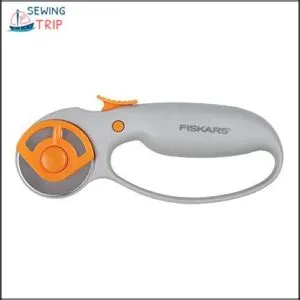
Anyone searching for a reliable fabric cutter will appreciate the Fiskars 45mm Contour Rotary Cutter. This tool features a precision-ground, stainless-steel blade that cuts cleanly through multiple fabric layers, paper, felt, and vinyl.
The curved handle design reduces hand strain during extended cutting sessions. You’ll find the loop over the handle prevents slippage when applying heavy pressure. The blade cover protects your fingers by exposing only the bottom cutting edge.
Safety features include a blade safety lock and pushbutton blade withdrawal system. The rotary blade assembles on either side, accommodating both right- and left-handed users.
At 2.89 ounces and measuring 1.13 x 3.75 x 9 inches, it’s lightweight yet sturdy. Replacement blades are readily available, and the easy blade-change mechanism makes maintenance simple. Fiskars backs this cutter with a lifetime warranty.
Best For: Quilters, crafters, and sewing enthusiasts needing precise, ergonomic cutting for fabrics, felt, and vinyl.
- Sharp stainless-steel blade for clean cuts through multiple fabric layers.
- Ergonomic curved handle reduces hand fatigue during extended use.
- Safety features like a blade lock and cover for user protection.
- Users report screw loosening during repeated use.
- Requires firm pressure for clean cuts on thicker materials.
- Blade dulls faster when used on non-fabric materials.
2. Fiskars 45mm Titanium Rotary Cutter with Comfort Grip
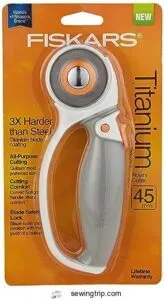
When precision meets comfort, you get the Fiskars 45mm Titanium Rotary Cutter with Comfort Grip. This powerhouse features a titanium-coated blade that’s three times harder than steel, delivering exceptional durability and lasting sharpness through countless projects.
The sculpted Softgrip handle reduces hand fatigue during extended cutting sessions, while its curved loop design provides superior control. You’ll appreciate the ambidextrous design that accommodates both right- and left-handed users by allowing blade assembly on either side for ideal visibility.
Safety features include a retractable blade with sliding button activation and thumb lock for secure storage. This versatile cutter slices through multiple fabric layers, batting, paper, lightweight leather, and foam board with ease. The titanium-coated blade maintains its sharp edge longer than standard steel blades, making it a reliable choice for serious quilters and crafters.
Best For: Crafters, quilters, and DIY enthusiasts looking for a durable, precise, and comfortable rotary cutter for various materials.
- Durable titanium-coated blade stays sharp longer than standard blades.
- Ergonomic Softgrip handle reduces hand fatigue during extended use.
- Ambidextrous design ensures usability for both right- and left-handed users.
- Limited cutting depth may not handle extra-thick materials like 2-inch foam.
- Blade retraction mechanism might confuse first-time users.
- Replacement blades sold separately, adding to long-term costs.
3. OLFA 60mm Ergonomic Rotary Cutter
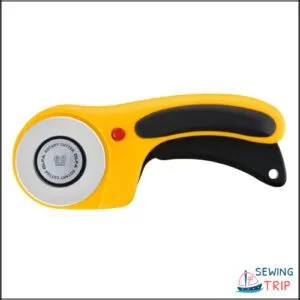
Heavy-duty cutting demands a powerhouse tool, and the OLFA 60mm Ergonomic Rotary Cutter delivers exactly that.
This beast handles up to 12 layers of cotton fabric in one smooth pass, making quick work of fleece, batting, and leather too.
The squeeze trigger handle reduces hand fatigue while the curved design minimizes wrist strain during extended cutting sessions.
You’ll appreciate the dual-action safety lock that secures the blade open or closed, plus the self-retracting feature that kicks in when you release pressure.
Whether you’re right-handed or left-handed, this cutter adapts to your grip.
It’s preloaded with OLFA’s premium Endurance blade for superior sharpness and twice the cutting life.
Best For: Professionals and hobbyists who require precise, heavy-duty cutting of multiple fabric layers and materials.
- Cuts up to 12 layers of fabric in one pass with a premium Endurance blade.
- Ergonomic design reduces hand and wrist fatigue during long use.
- Dual-action safety lock and self-retracting blade enhance safety.
- Contains DEHP, a chemical with potential health risks.
- Higher price point compared to standard rotary cutters.
- Requires blade replacements for continued optimal performance.
4. Olfa 28mm Standard Rotary Fabric Cutter

When precision matters most, the Olfa 28mm Standard Rotary Fabric Cutter delivers exceptional control for detailed work.
This compact powerhouse excels at maneuvering tight corners and intricate shapes that larger cutters can’t handle effectively.
You’ll appreciate its ambidextrous design, accommodating both right- and left-handed users with equal comfort.
The quick-change blade system makes replacements effortless, while the safety cover protects your fingers during storage.
Perfect for miniature quilting, doll patterns, and delicate paper crafts, this cutter isn’t built for heavy fabrics but shines with lighter materials.
Its durable handle reduces fatigue during extended sessions, making detailed projects less taxing on your hands.
Best For: Beginners and crafters working on detailed projects with light fabrics or delicate materials.
- Compact and easy to maneuver for tight corners and intricate shapes.
- Ambidextrous design suitable for both right- and left-handed users.
- Quick-change blade system for convenient blade swaps.
- Not suitable for heavy or thick fabrics.
- May require frequent blade changes with prolonged use.
- Smaller size may not be ideal for large-scale cutting projects.
5. Fiskars 45mm Rotary Fabric Cutter Titanium Blade
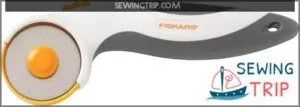
You’ll love how this Fiskars 45mm titanium-coated rotary cutter transforms your quilting experience.
The blade is three times harder than steel, delivering exceptional sharpness that lasts through countless projects. Its precision-ground construction cuts through multiple fabric layers, batting, and thicker materials with remarkable ease.
The ergonomically sculpted handle fits comfortably in both right and left hands, reducing fatigue during extended cutting sessions.
The sliding button mechanism extends, locks, and retracts the blade safely—no more accidental nicks or cuts.
This cutter pairs perfectly with self-healing mats and rolls smoothly against rulers without skipping. With Fiskars’ lifetime warranty backing the tool itself, you’re investing in reliable craftsmanship that’ll support your creative journey for years.
Best For: Quilters, crafters, and sewing enthusiasts who need a durable, sharp rotary cutter for precise cutting of multiple fabric layers and thicker materials.
- Blades may dull faster than expected for some users.
- Replacement blades are sold separately and not covered under warranty.
- A self-healing cutting mat is strongly recommended for optimal performance, adding to overall costs.
- Titanium-coated blade is three times harder than steel for lasting sharpness.
- Ergonomic handle reduces hand fatigue and works for both right- and left-handed users.
- Sliding button mechanism ensures safe blade locking and retraction.
6. Martelli Ergo 2000 60mm Rotary Cutter Right Handed
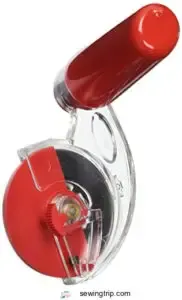
Right-handed quilters often struggle with rotary cutters that cause wrist pain and fatigue.
The Martelli Ergo 2000 60mm Rotary Cutter changes everything with its innovative design.
This cutter’s doughroller-style grip promotes natural hand positioning, reducing strain during extended cutting sessions.
The tungsten steel blade lasts 3-5 times longer than standard blades and cuts through 6-8 fabric layers effortlessly.
The spring-loaded safety guard protects you and your blade with a simple finger flip.
Developed with input from orthopedic surgeons, this tool transforms marathon quilting sessions from painful to pleasant.
Your hands will thank you after hours of comfortable, precise cutting through cotton, wool, and everything in between.
Best For: Right-handed quilters seeking a durable, ergonomic rotary cutter for extended cutting sessions.
- Ergonomic design reduces wrist pain and fatigue.
- Tungsten steel blade cuts 6-8 layers and lasts 3-5 times longer than standard blades.
- Spring-loaded guard enhances safety and blade longevity.
- Only available in a right-handed version (blue grip needed for left-handed users).
- Larger 60mm blade may be less precise for intricate cuts.
- Occasionally listed as out of stock, requiring restock notifications.
7. Nicapa 45mm Rotary Cutter with 5 Extra Blades
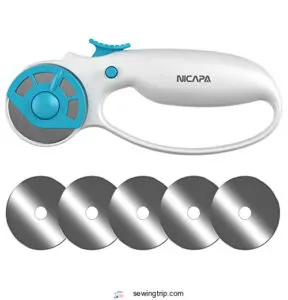
Value meets functionality in the Nicapa 45mm Rotary Cutter with 5 extra blades.
You’ll appreciate its precision-ground stainless steel blade that cuts cleanly through fabric, paper, felt, and vinyl. The curved loop-handle design fits naturally in your hand, reducing fatigue during extended quilting sessions.
This ambidextrous cutter works for both right- and left-handed users, while the safety button locks the blade securely when not in use.
At just $34.99, you’re getting exceptional value with five replacement blades included.
The ergonomic pink handle provides comfortable control, and the quick blade replacement mechanism keeps you working efficiently.
Perfect for quilters who want quality without breaking the bank.
Best For: Quilters, crafters, and DIY enthusiasts looking for an affordable, ergonomic, and versatile rotary cutter.
- Sharp 45mm blade with 5 extra replacements for durability.
- Ergonomic ambidextrous handle reduces hand fatigue.
- Safety lock feature ensures secure blade storage.
- Only available in two color options (white and pink).
- Fixed-size blade may not suit specialized cutting tasks.
- Requires careful handling to avoid accidental cuts despite safety features.
8. Olfa RTY 2G Rotary Fabric Cutter
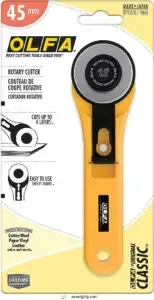
You’ll appreciate how the Olfa RTY 2G Rotary Fabric Cutter cuts straight to the point.
This 45mm tungsten steel blade maintains its sharp edge longer than standard cutters, slicing through fabric, paper, leather, and vinyl with consistent precision.
The straight handle design works perfectly for both right and left-handed quilters.
Its textured grooves provide a secure grip during extended cutting sessions, reducing hand fatigue.
The included blade guard keeps you safe between projects.
What sets this cutter apart is its ability to handle multiple fabric layers without dragging or pulling.
Users consistently praise its smooth rolling action and lightweight construction.
It’s particularly effective for quilting strips and precise pattern pieces, making it a reliable choice for serious crafters.
Best For: Quilters, crafters, and sewing enthusiasts who need a precise and efficient tool for cutting fabric, leather, and other materials.
- Smaller blade size may require more frequent blade changes for extensive use.
- Sharper blade needs careful handling to avoid accidents.
- Straight handle design may not suit users preferring contoured grips.
- Sharp tungsten steel blade for cutting through multiple layers with ease.
- Comfortable, ergonomic straight handle for left- and right-handed users.
- Blade guard ensures safety when not in use.
9. Electric Rotary Fabric Cutter 100mm Purple
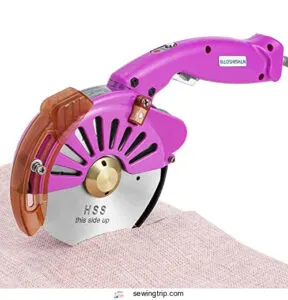
When cutting fabric feels like watching paint dry, the Electric Rotary Fabric Cutter 100mm Purple changes everything.
This 8V battery-powered beast cuts through 10-20 fabric layers in seconds—cotton, leather, wool, or thick carpets.
Its 100mm octagonal blade spins fast with five adjustable speeds, while three smooth rollers keep your cuts straight.
The LED light helps you see clearly in dim workspaces.
Plus, there’s a built-in whetstone that sharpens the blade without removal—genius, right?
Its lightweight design reduces hand fatigue during marathon cutting sessions.
Perfect for mass production and repetitive cuts, though you’ll want electric scissors for tight corners.
Best For: Professionals and hobbyists needing an efficient tool for cutting multiple layers of fabric in mass production or repetitive tasks.
- Cuts up to 20 layers of fabric quickly and precisely.
- Lightweight, ergonomic design reduces hand fatigue.
- Built-in sharpening system maintains blade efficiency.
- Not ideal for cutting tight or intricate corners.
- Cordless operation may require frequent battery charging.
- Higher price point compared to basic electric scissors.
Cutter Maintenance Tips
Proper maintenance keeps your rotary cutter performing at its best and extends its lifespan substantially.
You’ll need to change blades regularly, clean the tool after each use, and store old blades safely to maintain cutting precision.
Regular Blade Changes
Maintaining blade sharpness is vital for clean, professional cuts.
Dull blades create frayed edges and require extra pressure, affecting your blade durability and cutting precision.
Proper care guarantees optimal cutting performance.
Monitor these signs for superior blade replacement:
- Sharpness Importance: Replace when cuts feel rough or require excessive force
- Changing Frequency: Frequent quilters should swap blades every few projects
- Blade Longevity: Heavy fabric users need more frequent changes than occasional crafters
- Blade Disposal: Store old rotary blades in marked containers for safety
Fresh blades guarantee effortless blade maintenance and superior results.
Cleaning The Rotary Cutter
Why let fabric lint and adhesive buildup dull your cuts? Regular cutter maintenance keeps your rotary tool performing like new.
Blade disinfection with alcohol prevents bacterial growth, while residue removal eliminates sticky buildup that affects blade sharpness. Don’t forget handle cleaning and mat debris removal—these affect cutting precision too.
| Task | Frequency |
|---|---|
| Blade Disinfection | Weekly with alcohol wipes |
| Residue Removal | After sticky fabric projects |
| Handle Cleaning | Monthly deep clean |
Storing Old Blades Safely
After cleaning your rotary cutter, you’ll accumulate dull blades that need proper storage. Never toss loose blades in regular trash—they’re sharp hazards.
Here are smart blade storage tips for safe disposal methods:
- Use sharps containers or sturdy jars with tight lids for old blade organization
- Wrap individual blades in tape before storing in blade protective cases
- Keep containers high for child safety and pet precautions
- Check local recycling options for metal blade disposal
- Label storage clearly to prevent accidents
Effective Cutting Techniques
Mastering proper cutting techniques transforms your rotary cutter from a simple tool into a precision instrument that creates clean, accurate cuts every time.
You’ll achieve professional results by applying steady pressure, layering fabric correctly, and using consistent rolling motions that keep your blade sharp and your cuts straight, which helps in achieving professional results.
Proper Cutting Technique
Perfect rotary cutter technique starts with proper setup and positioning.
Smooth your fabric flat for fabric stabilization, then position your ruler firmly. Hold the rotary cutter at a 45-degree blade angle while maintaining steady hand positioning.
Roll the blade along the ruler’s edge with consistent pressure.
| Setup Step | Key Technique |
|---|---|
| Cutting Mat Use | Place fabric on self-healing mat |
| Ruler Placement | Align ruler with cutting line |
| Fabric Alignment | Smooth out wrinkles completely |
Steady Pressure for Clean Cuts
Master consistent pressure with your rotary cutter to achieve clean, professional cuts every time.
Light pressure causes fabric snagging, while excessive force strains your hand and dulls the blade.
Here are five essential pressure techniques:
- Hand Placement – Position your dominant hand naturally on the handle
- Blade Sharpness – Replace dull blades immediately for effortless cutting
- Fabric Stability – Secure fabric edges before cutting begins
- Cutting Mats – Use quality mats that complement your fabric tension
- Steady Pressure – Apply even force throughout each cut for cutting accuracy
Layering Fabric for Multiple Cuts
Once you’ve mastered steady pressure, fabric layering multiplies your cutting efficiency.
Stack up to four fabric layers on your cutting mat for maximum fabric stability. Your rotary cutter’s blade sharpness handles multiple fabric layers with proper pressure control.
- Time saver: Cut four pieces in one pass instead of four separate cuts
- Consistency boost: All fabric cutting tools deliver uniform results across layers
- Precision power: Fabric layering guarantees identical pattern pieces every time
Rotary Cutter Applications
You’ll discover that rotary cutters excel at multiple fabric cutting tasks, from precise quilting strips to pattern pieces for clothing projects.
These versatile tools handle everything from single-layer detail work to cutting through thick fabric stacks, making them essential for efficient sewing and crafting workflows, and they are particularly useful for efficient tasks.
Precise Straight Line Cutting
Achieving perfect straight lines starts with your setup. Position fabric flush against your cutting mat’s grid lines for Fabric Stability. Your acrylic ruler becomes your best friend here – press it down firmly while keeping your rotary cutter perpendicular to avoid wonky Cutting Angles.
Blade Sharpness makes or breaks precision cutting, so swap dull blades immediately. Mat Quality matters too – those worn grooves will derail your cuts.
Ruler Use requires steady pressure and slow, deliberate movement for flawless fabric cutting results.
Fabric Cutting for Quilting
Quilting demands precision, and your rotary cutter delivers every time.
Different quilting fabric types require specific approaches—cotton cuts smoothly, while batting needs firm pressure.
Cutter size matters when working through patchwork quilting pieces.
Always use your mat and ruler combo for accurate measurements.
For cutting intricate designs, maintain steady control.
While rotary cutter alternatives exist, nothing beats this essential fabric cutting tool for quilting fabric preparation.
Cutting Through Multiple Fabric Layers
Your rotary cutter transforms fabric cutting when you’re working with multiple layers.
Stack fabric evenly on cutting mats, ensuring proper fabric compression without bunching. Blade sharpness directly impacts cutting efficiency through thick fabric layers.
Key techniques for success:
- Maintain consistent pressure control throughout each cut
- Check your cutter’s layer capacity before stacking
- Use rulers to guide straight lines
- Cut with smooth, continuous motions
This method saves time while delivering precise results across various fabric thickness levels.
Using With Templates
Beyond cutting multiple layers, your rotary cutter transforms into a precision instrument when paired with templates.
Template materials like acrylic or cardboard guide your rotary blade through complex shapes that scissors can’t handle.
Template Types and Uses:
| Template Material | Best For | Securing Method | Curve Cutting | Pattern Matching |
|---|---|---|---|---|
| Acrylic rulers | Straight lines | Weight down | Limited | Excellent |
| Cardboard shapes | Simple curves | Tape edges | Good | Fair |
| Plastic stencils | Detailed work | Hold firmly | Excellent | Good |
| Metal guides | Heavy fabrics | Clamp down | Limited | Excellent |
| Paper patterns | One-time use | Pin carefully | Fair | Good |
Place templates on your cutting mat, secure them firmly, and roll your rotary cutter along edges.
This method reduces fabric waste while ensuring consistent pattern cutting for quilting projects.
Cutting Pattern Pieces for Clothing
Template work sets you up perfectly for garment construction.
Your rotary cutter excels at cutting clothing patterns with surgical precision. Place pattern pieces on fabric, respecting the fabric grain direction. Use marking tools to transfer notches and darts before cutting.
Essential pattern cutting steps:
- Check seam allowance measurements before cutting
- Position pattern layout strategically for fabric efficiency
- Master curve cutting techniques for armholes and necklines
- Maintain steady pressure for clean, professional edges
Frequently Asked Questions (FAQs)
Are rotary cutters good for cutting fabric?
Absolutely, you’ll find these blade-wheeled companions are fabric-cutting champions.
They slice through multiple layers with surgical precision, making quilting and sewing projects faster than scissors.
You’ll appreciate their ergonomic handles and safety features during extended crafting sessions.
What is the best tool to cut fabric with?
You’ll find rotary cutters are the gold standard for fabric cutting.
They deliver precise, clean cuts through multiple layers while reducing hand fatigue.
For delicate work, sharp fabric scissors remain essential companions.
What is the best fabric cutting wheel?
Nothing beats a titanium-coated rotary cutter for fabric cutting perfection.
You’ll want a 45mm blade for quilting versatility, while 60mm handles thick layers effortlessly.
Fiskars and Olfa offer ergonomic grips that’ll save your wrists during marathon sewing sessions.
What is the best tool for cutting fabric?
Rotary cutters top the list for fabric cutting precision.
You’ll get cleaner cuts than scissors, handle multiple layers effortlessly, and work faster on quilting projects.
Choose 45mm blades for most tasks.
Which is better, a 45mm or 60mm rotary cutter?
Choose 45mm for quilting and general sewing projects—it’s the sweet spot for versatility and control.
Go with 60mm when you’re cutting thick fabrics or multiple layers regularly, but expect less precision on curves.
How do you cut fabric straight with a rotary cutter?
Precision becomes effortless when you align your ruler perfectly with fabric edges, apply steady downward pressure, and roll your rotary cutter smoothly along the ruler’s edge in one continuous motion.
What rotary cutter is best for beginners?
Start with a 45mm rotary cutter featuring an ergonomic handle and safety lock. The Fiskars 45mm Titanium Comfort Grip offers durability, ambidextrous design, and beginner-friendly features for accurate cuts.
How to prevent fabric slipping while cutting?
Ironically, the smoothest cuts happen when fabric can’t move.
You’ll need a quality cutting mat, sharp rotary blade, and firm downward pressure.
Pin layers together or use fabric weights to keep everything perfectly still.
Can rotary cutters cut non-fabric materials?
Yes, you can cut various materials beyond fabric with rotary cutters.
They handle paper, cardboard, vinyl, and thin leather effectively.
However, avoid delicate materials like chiffon, as they may snag or tear during cutting, especially with delicate materials.
What’s the difference between manual and electric cutters?
Manual cutters require your hand power, electric cutters use motor power.
You’ll control manual cutters completely, while electric ones offer consistent speed but less precision.
Manual versions cost less, electric models handle thick materials effortlessly.
Conclusion
Despite concerns about the initial investment, rotary fabric cutting tools quickly pay for themselves through improved accuracy and time savings.
You’ve discovered nine excellent options that’ll transform your cutting precision from amateur to professional level.
Remember to match blade sizes with your fabric thickness, maintain sharp blades through regular replacement, and always use proper cutting mats.
With consistent practice and the right rotary fabric cutting tools, you’ll achieve clean, straight cuts that make your quilting projects shine.
- https://suzyquilts.com/quilting-rotary-cutters-a-complete-guide/
- https://modernmoonquiltstudio.com/best-rotary-cutters-for-quilting-and-sewing/
- https://www.gathered.how/sewing-and-quilting/quilting/best-rotary-cutters/
- https://shop.archsupplies.com/products/olfa-rty-2-g-straight-handle-rotary-cutter-45mm?srsltid=AfmBOooyQUqGa_34na25CmCDrzi32FeTb2kuBUMyMGixD_Gl57d9PWdW
- https://olfa.com/products/olfa-45mm-rty-2-g-straight-handle-rotary-cutter?srsltid=AfmBOoqEf1vtDNrF-_v1fjWAAW30Qli2_zW1I--tZGlDn4flfGCp01IC

